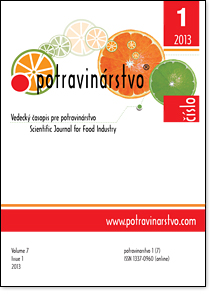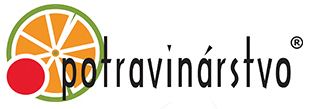Contribution of temporal dominance of sensations method to the sensory description of taste properties of commercial green tea brands
DOI:
https://doi.org/10.5219/274Keywords:
temporal dominance of sensations (TDS), dominance rate, attribute, green teaAbstract
This paper aims to investigate the most dominant taste attributes of green tea samples in panelists perception over time. In order to assess the samples, a brand new method of sensory evaluation called „Temporal Dominance of Sensations“ was used. The five commercial green tea brands were evaluated by eight trained panelists (students). For each sample of green tea, curves of the dominance of each attribute over time were computed. The TDS curves provided information about the sequence of attributes that were dominant during degustation. This methodology was useful to characterize taste properties of green tea samples.
Downloads
Metrics
References
Albert, A., Salvador, A., Schlich, P., Fiszman, S. 2012. Comparison Between Temporal Dominance of Sensations (Tds) And Key-Attribute Sensory Profiling for Evaluating Solid Food with Contrasting Textural Layers: Fish Stiks. Food Quality And Preference, vol. 24, no. 1, p. 111-118. https://doi.org/10.1016/j.foodqual. 2011.10.003 DOI: https://doi.org/10.1016/j.foodqual.2011.10.003
Bruzzone, F., Ares, G., Giménez, A. 2013. Temporal Aspects of Yoghurt Texture Perception. International Dairy Journal, vol. 29, no. 2, p. 124-134. https://doi.org/10.1016/j.idairyj.2012.10.012 DOI: https://doi.org/10.1016/j.idairyj.2012.10.012
Dinnella, C., Masi, C., Zoboli, G., Monteleone, E. 2012. Sensory Functionality Of Extra-Virgin Olive Oil In Vegetable Foods Assessed by Temporal Dominance of Sensations And Descriptive Analysis. Food Quality And Preference, vol. 26, no. 2, p. 141-150. https://doi.org/10.1016/j.foodqual. 2012.04.013 DOI: https://doi.org/10.1016/j.foodqual.2012.04.013
Labbe, D., Schlich, P., Pineau, N., Gilbert, F., Martin, N. 2009. Temporal Dominance of Sensations and Sensory Profiling: A Comparative Study. Food Quality And Preference, vol. 20, no. 3, p. 216-221. DOI: https://doi.org/10.1016/j.foodqual.2008.10.001
Laguna, L., Varela, P., Salvador, A., Fiszman, S. 2013. A New Sensory Tool to Analyse the Oral Trajectory of Biscuits With Different Fat And Fibre Contents. Food Research International, vol. 51, no. 2, p. 544-553. https://doi.org/ 10.1016/j.foodres.2013.01.003 DOI: https://doi.org/10.1016/j.foodres.2013.01.003
Le Révérend, F. M., Hidrio, C., Fernandes, A., Aubry, V. 2008. Comparison Between Temporal Dominance of Sensations and Time Intensity Results. Food Quality And Preference, vol. 19, no. 2, p. 174-178. https://doi.org/10.1016/j.foodqual.2007.06.012 DOI: https://doi.org/10.1016/j.foodqual.2007.06.012
Lenfant, F., Loret, C., Pineau, N., Hartmann, C., Martin, N. 2009. Perception of Oral Food Breakdown. The Concept of Sensory Trajectory. Appetite, vol. 52, no. 3, p. 659-667. PMid:19501764 DOI: https://doi.org/10.1016/j.appet.2009.03.003
Meillon, S., Urbano, C., Schlich, P. 2009. Contribution Of The Temporal Dominance Of Sensations Method to the Sensory Description Of Subtle Differences Partially Dealcoholized Red Wines. Food Quality And Preference, vol. 20, no. 7, p. 490-499. https://doi.org/10.1016/ j.foodqual.2009.04.006 DOI: https://doi.org/10.1016/j.foodqual.2009.04.006
Ng, M., Lawlor, J. B., Chandra, S., Chaya, C., Hewson, L., Hort, J. 2012. Using Quantitative Descriptive Analysis And Temporal Dominance of Sensations Analysis as Complementary Methods For Profiling Commercial Blackcurrant Squashes. Food Quality And Preference, vol. 25, no. 2, p. 121-134. https://doi.org/10.1016/ j.foodqual.2012.02.004 DOI: https://doi.org/10.1016/j.foodqual.2012.02.004
Pavelková, A., Flimelová, E., Vietoris, V. 2012. Sensory Evaluation Of Fresh Cheese Taste With The Addition Of Oregano. Potravinárstvo, vol. 6, no. 1, p. 34-36. DOI: https://doi.org/10.5219/176
Pineau, N., Goupil De Bouillé, A., Lepage, M., Lenfant, F., Schlich, P., Martin, N., Rytz, A. 2012. Temporal Dominance of Sensations: What is a Good Attribute List? Food Quality And Preference, vol. 26, no. 2, p. 159-165. https://doi.org/10.1016/j.foodqual.2012.04.004 DOI: https://doi.org/10.1016/j.foodqual.2012.04.004
Pineau, N., Schlich, P., Cordelle, S., Mathonniére, C., Issanchou, S., Imbert, A., Rogeaux, M., Etiévant, P., Köster, E. 2009. Temporal Dominance of Sensations: Construction of the TDS Curves and Comparison With Time-Intensity. Food Quality And Preference, vol. 20, no. 6, p. 450-455. https://doi.org/10.1016/j.foodqual.2009.04.005 DOI: https://doi.org/10.1016/j.foodqual.2009.04.005
Saint-Eve, A., Déléris, I., Panouillé, M., Dakowski, F., Cordelle, S.,Schlich, P., Souchon, I. 2011. How Texture Influences Aroma and Taste Perception Over Time in Candies. Chemosensory Perception, vol. 4, no. 1-2, p. 32-41. DOI: https://doi.org/10.1007/s12078-011-9086-4
Vietoris, V. 2010. Software TI-TDS. Release 1.1. 2010.
Downloads
Published
How to Cite
Issue
Section
License
This license permits non-commercial re-use, distribution, and reproduction in any medium, provided the original work is properly cited, and is not altered, transformed, or built upon in any way.






























